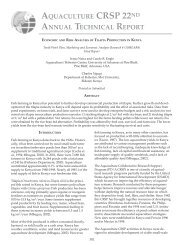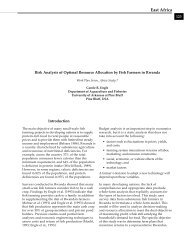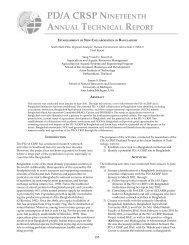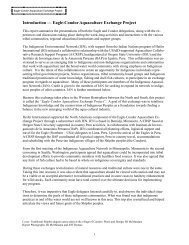manual of fertilization and supplemental feeding strategies
manual of fertilization and supplemental feeding strategies
manual of fertilization and supplemental feeding strategies
You also want an ePaper? Increase the reach of your titles
YUMPU automatically turns print PDFs into web optimized ePapers that Google loves.
A MANUAL FOR FERTILIZATION YI, LIN & DIANA<br />
3. POND PREPARATION<br />
3.1 Importance <strong>of</strong> pond preparation<br />
Pond preparation is an essential practice to the success <strong>of</strong> fish culture. Good pond preparation<br />
can serve a number <strong>of</strong> purposes:<br />
• Sterilize <strong>and</strong> improve soil quality <strong>of</strong> ponds;<br />
• Induce production <strong>of</strong> natural foods;<br />
• Increase tilapia survival;<br />
• Maintain tilapia health;<br />
• Ensure good growth <strong>and</strong> yield.<br />
3.2 Procedures <strong>of</strong> pond preparation<br />
Drain water from ponds completely <strong>and</strong> let ponds dry for 1-2 weeks until the bottom mud cracks.<br />
Upon drying, air <strong>and</strong> sunlight can enhance oxidation <strong>of</strong> reduced chemical compounds in pond<br />
bottom, <strong>and</strong> eradicate unwanted organisms, predators <strong>and</strong> micro-organisms.<br />
Liming is an important procedure to increase alkalinity <strong>and</strong> pH in pond soil, maintain pH (7-8) in<br />
pond water, provide sufficient CO2 for phytoplankton growth, <strong>and</strong> enhance good response to<br />
<strong>fertilization</strong>.<br />
There are several liming materials available. The most commonly used liming materials are<br />
quick lime (CaO), slaked lime (Ca(OH)2) <strong>and</strong> agricultural lime (CaCO3). Agricultural lime is<br />
inexpensive <strong>and</strong> easy to use, but has lower neutralizing value. Slaked lime is quite reactive <strong>and</strong><br />
thus should be h<strong>and</strong>led with care. Quick lime is the most reactive <strong>and</strong> hence dangerous to use. It<br />
reacts vigorously with water to become slaked lime, the process that generates heat <strong>and</strong> raises pH<br />
rapidly.<br />
The amount <strong>of</strong> lime applied to ponds depends on the nature <strong>of</strong> the soil <strong>and</strong> history <strong>of</strong> ponds. In<br />
general, newly dug ponds require greater amount <strong>of</strong> initial lime input than aged ponds; loamy<br />
soil needs less lime than clayey <strong>and</strong> acid soil.<br />
The liming rates commonly used in Thail<strong>and</strong> are as followings:<br />
• If ponds are newly dug, <strong>and</strong> have never been limed, one <strong>of</strong> these rates should be used:<br />
Agricultural lime 1,000 kg/ha<br />
Slaked lime 750 kg/ha<br />
Quick lime 550 kg/ha<br />
• If ponds are old <strong>and</strong> have been limed before, one <strong>of</strong> these rates is appropriate:<br />
Agricultural lime 500 kg/ha<br />
Slaked lime 375 kg/ha<br />
Quick lime 275 kg/ha<br />
These recommendations may vary <strong>and</strong> should be adapted to local conditions based on an acidity<br />
test <strong>of</strong> pond mud.<br />
3







